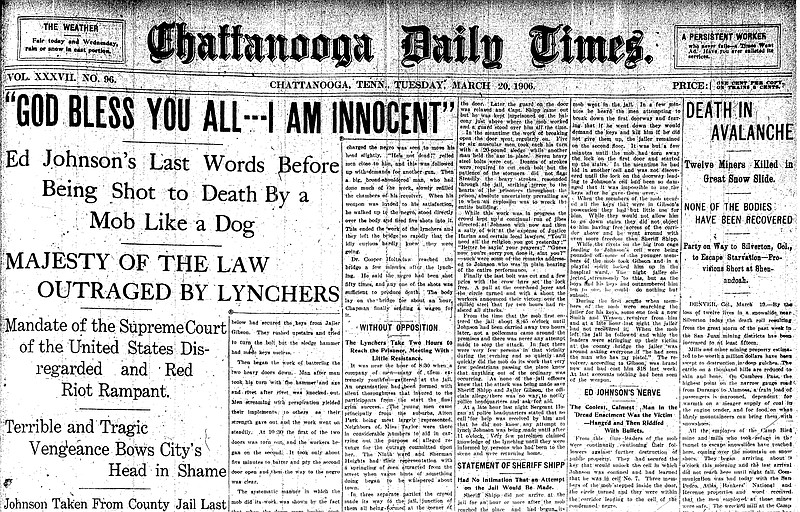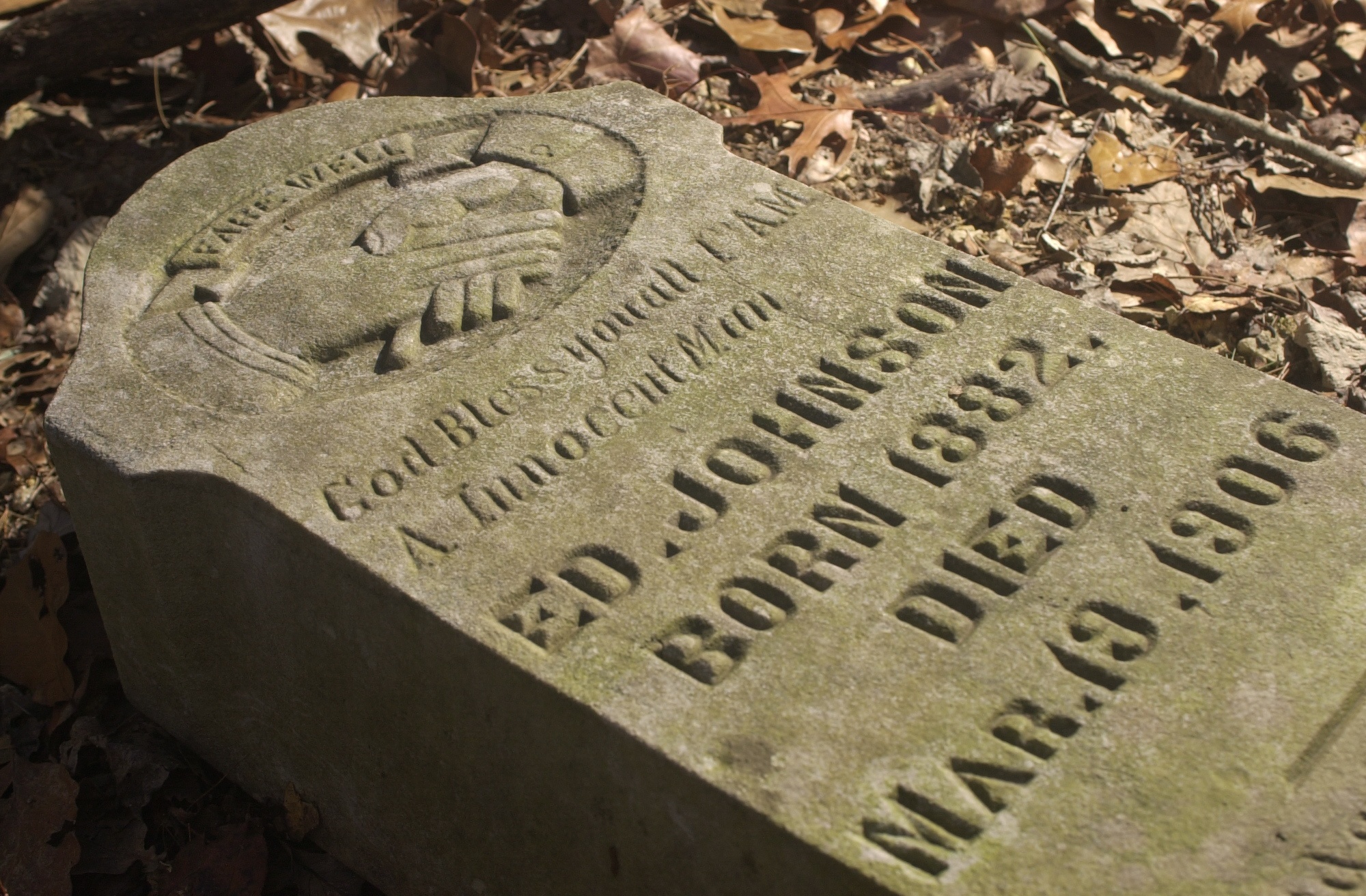"It advertised Chattanooga all over this land and in foreign lands as a place where it is unsafe to live. It registered our city as among that class of communities which have only attained a very low grade of civilization, a place where intelligence flees with fear and trembling when ignorance clenches its fists and gnashes its teeth."
- Dr. Howard E. Jones, First Baptist Church Chattanooga, March 25, 1906
Jerry Mitchell is a respected journalist living in Jackson, Mississippi. As an investigative journalist with the Jackson Clarion-Ledger between 1986 and 2018, Mitchell began in 1989 to investigate cold cases from the civil rights era, and his reporting put at least four members of the Ku Klux Klan behind bars.
Mitchell's work as a journalist is credited with inspiring Mississippi and six other states to reexamine 29 killings from the civil rights era. Twenty-seven men were arrested and 22 convicted.
He knows the story of Ed Johnson but until this week had not seen the front page of the March 20, 1906, Chattanooga Daily Times, which reported on Johnson's shooting and lynching the night before.
"Wow, that is wild," said Mitchell, who left the Clarion Ledger and formed the Mississippi Center for Investigative Reporting in 2018. "I have never seen anything remotely close to that in all my years of digging through microfilm. All those headlines."
Johnson was lynched and shot on the "county bridge" at 11 p.m. on March 19, 1906, when a small mob of white men took Johnson from his cell and led him to his death. Johnson was arrested on Jan. 23, 1906, for the rape of Nevada Taylor in St. Elmo. He was convicted on Feb. 11. , and held in Knoxville. Johnson was sent back to Chattanooga on March 11 following a failed appeal to the U.S. Circuit Court.
Johnson's attorneys appealed to U.S. Supreme Court Justice John Marshall Harlan on Saturday, March 17, restating the argument that Johnson had not received a fair trial. At 1 p.m. on March 19, Harlan sent a telegram to Hamilton County Sheriff Joseph F. Shipp. Shipp was informed of the stay around 2 p.m., and told Johnson was now a federal prisoner. The telegram arrived in Chattanooga around 3:30 p.m. By shortly after 11 p.m., Johnson was dead. G.W. Franklin, the first African American funeral director and embalmer in Chattanooga, picked up Johnson's body from the bridge.
***
The March 20, 1906, front page of the Chattanooga Daily Times (1 cent; 6 cents on the train) provided a highly detailed account of the death of Ed Johnson. The journalist's account leaves every impression that he witnessed the attack on the county jail from its beginnings at 8 p.m. and followed it through Johnson's death at the Walnut Street Bridge.
The death of Johnson consumed two-thirds of the front page and A1 contained a staggering 171 words and five complete sentences of headlines in what would likely be one of the most unique front-page designs in the 150-year history of newspapers in Chattanooga.
A reader of the morning paper would have a complete picture of the basics of the story by reading only the 12 separate and distinct headlines that preceded the lead story. Newspaper editors use a few words in headlines to summarize a story; using multiple complete sentences is rare.
The headlines were lined up down the left side of the seven-column page, grew smaller as they descended and rotated between headlines with all capital letters and those with upper- and lower-case letters.

View our 150 years anniversary coverage
The bold banner declared, "GOD BLESS YOU ALL--I AM INNOCENT"
"Ed Johnson's Last Words Before Being Shot to Death by a Mob Like a Dog"
"MAJESTY OF THE LAW OUTRAGED BY LYNCHERS"
"Mandate of the Supreme Court of the United States Disregarded and Red Riot Rampant."
"Terrible and Tragic Vengeance Bows City's Head in Shame"
"Johnson Take From County Jail Last Night, Marched to County Bridge and Hung White Red Rioters Complete Their Hideousness By Riddling Body With Bullets."
"NIGHT OF WICKEDNESS AND WOE"
"Practically No Resistance Offered the Lynchers Who Numbered Less Than One Hundred Men."
"Only the Night Jailer Present When the Mob Makes the Onslaught on the County Prison."
"SHERIFF SHIPP FORCED INTO A BATH ROOM"
"POLICE AND DEPUTIES NOT IN EVIDENCE, AND MOB WORKS UNINTERRUPTED FOR TWO HOURS."
"The Tragedy on the County Bridge an Exhibition of Passion Unparalleled in the History of Chattanooga-The Helpless Victim Strung Up to a Beam of the Bridge-The Rope Breaks Before Strangulation Is Accomplished and the Falling Body is Riddled by Bullets."
The lead story contained only 13 paragraphs, most more than 200 words in length. Virtually all articles on Johnson describe him as being lynched, but the first-day reporting reinforced the headline that said Johnson was shot.
The lead paragraph reports, "Protesting his innocence to the last and with the words 'God bless you all' on his lips, Ed Johnson, the negro convicted of assaulting Miss Nevada Taylor in St. Elmo on the night of Jan. 23, was shot to death on the county bridge last night."
The 11th paragraph gave more detail, reporting, "Finally, it was decided that the time was being wasted, and the order to hoist up the negro was given. Eager hands began to pull, but the rope slipped and more time had to be spent in adjusting it. When the hoisting finally began, the now frenzied lynchers could restrain themselves no longer, and a fusillade of shots was turned loose. One of the first bullets cut the rope and the body came tumbling to the bridge floor. Then the frenzied men from the suburban district, every one of whom had a gun or pistol, gathered around and emptied the contents of their weapons into the prostrate negro."
The next paragraph continued, "When all the firearms had been discharged the negro was seen to move this head slightly. "he's not dead!" yelled men close to him, and this was followed up with demands for another gun. Then, a big, broad-shouldered man, who had done much of the work, slowly refilled the chambers of his revolver. When his weapon was loaded to his satisfaction, he walked up the negro, stood directly over the body and fired five shots into it."
The report says, "Johnson's life was ended just as the court house clock struck 11." It goes on to describe a "quiet city" four hours earlier. It says, "the negro was resting comfortably in this cell" and was pleased with the Supreme Court's precedent-setting action to stay his execution. The story says that a half hour later, there were rumors of a lynching, "but nobody seemed to take the report seriously.
A dozen men, "a few with handkerchiefs over the lower part of their faces and the rest undisguised in any manner," entered the county jail at 8 p.m. They would be there for two hours, facing no resistance from the lone person on duty. Minutes later, six more men came. "Close upon the heels of these a few more strolled in. In all, there were only about twenty-five, but each man seemed to know just what to do and the twenty-five did the work as effectually as it could have done by hundreds."
When the mob got to the bridge, the mob offered Johnson a chance to confess in his last words. He refused. The report says, "To all questions and demands for a confession he would only say, 'I'm ready to die, but I never done it."
The front page included a story that goes into extensive detail about the two hours the mob spent in the county jail, a story with Sheriff Shipp's version of events and a third that described Johnson as he was taken from his cell, down a stairway and out into the streets. "The prisoner was the calmest person in the jail," the report says. "Not a quiver of the lip or utterance of a sound betrayed the slightest fear or terror."
The reporting continued on page two of the 10-page newspaper with four additional stories, all of which were mentioned in one of the 12 headlines on the front page. What served as the editorial page in 1906 featured the mood of the community, as expressed by the paper owned by Adolph Ochs.
"In circumstances of this kind," he writes, "all that the good citizen can do is to bow his head in shame and look for better things in the future."
***
A memorial to Ed Johnson is currently being created by artist Jerome Meadows in Savannah, Ga. Organizers of the Ed Johnson Project said the cost of the project was $525,000 in March 2018. The project is to include the memorial, a documentary, a scholarship fund and an academic curriculum.
Longtime Chattanooga resident Dr. Eleanor McCallie Cooper joined the Ed Johnson Project a few months into the planning in summer of 2017, which began the final push to build a memorial discussed since 2005. She's hopeful the statutes of Johnson, Noah Parden and Styles Hutchins on the south side of the Walnut Street Bridge - not on the bridge - will be ready to mark the 113th anniversary of Johnson's death in April 2020. She looks forward to the day the memorial will be part of the U.S. Civil Rights Trail.
"Our community will be glad we did this because we will be part of a regional and national effort to highlight the civil rights history of the United States," said Cooper. "This will be a great addition to the trail. People will come to the South just to see the trail. The interest and publicity will create more tourism.
"The sermon the Sunday after Johnson died reflected what the community felt. It was a small group of people who did this. This is a compelling story, and people will come and see that we have embraced [our history] because we are not that kind of people."

